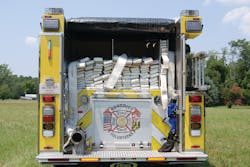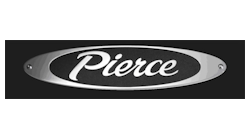Innovative Rigs on the Street: Benedict's Engine 51
During the course of my travels I sometimes have the opportunity to visit fire stations that are off the beaten path and nested in areas where you still need an old fashioned map to help find your way. Departments in many communities were organized and became the hub for local activities and gatherings for residents to share information. These smaller departments across the United States provide fire and emergency services while enhancing their operations through education and training.
The Benedict Volunteer Fire Department and Rescue Squad is located in Charles County, MD, and was organized in 1950. A few years earlier, after a fire in the community, several influential citizens banded together and purchased a used 1929 International pumper to provide fire protection. The pumper was stored in a small shed across from the ferry slip and when needed the apparatus would be jump started with a battery supplied by the ferry company. The first fire station was built on land donated by Joseph Higdon and a second International pumper was placed into service.
The Department Today
The fire department today is under the command of Chief Sean Kerrigan and operates with two pumpers, a tanker, a mini-pumper, a brush truck, an ambulance and five support units. The department annually responds to incidents in both Charles and Calvert County with all volunteer staffing. The department’s apparatus history is interesting with their first new apparatus being a FWD closed cab 750 gpm pumper delivered in May 1956. Following the acquisition of this unit, new pumpers built by Barton American were acquired in 1964 and 1975.
The Benedict Fire Department placed into service their first custom chassis apparatus in 1983 with a Hahn 1250 gpm pumper that was assigned as Engine 52. The department’s rural water supply capabilities were enhanced with the arrival of Pierce Lance 2,000-gallon pumper tanker in 1990. The fleet today consists of a 2003 Pierce Dash rescue engine equipped with a 1,750 gpm pump, 750-gallon water tank and a 25-gallon foam tank together with a 2001 Peterbilt 379 pumper tanker built by Four Guys. Tanker 5 carries 3,800 gallons of water, 200 gallons of Class B foam and is equipped with a 1,000 gpm pump. Brush 54 is a 2008 Ford F-350 unit built by DPC equipped with a 150 gpm pump and 200-gallon water tank.
New Engine 51
The department’s newest apparatus, assigned as Engine 51, is a 2011 Pierce Arrow XT pumper. This unit is built with a 184 ½-inch wheelbase with an overall length of 30 feet, 10 inches. The chassis is equipped with a 21,500-pound rated front axle, 27,000-pound rear axle and is powered by a Detroit Diesel DD13 engine rated at 500 horsepower with an Allison EVS-4000 transmission.
The front bumper is a stainless steel “Chicago style” incorporating room for a five-inch front suction, 2 ½-inch front trash line discharge and hose well to accommodate the soft sleeve and 1 ¾-inch hand line. The aluminum cab provides seating for six personnel and is equipped with front and side air bags to protect the members, together with a Firecom headset communication system.
The apparatus carries a Hale Q-Max 2000 gpm single-stage fire pump, 750-gallon FDNY-style water tank with a Feecon around the pump foam system rated at 1,400 gpm supplied by a 30-gallon foam tank. While the apparatus is outfitted with a good number of preconnected hand lines, the pump panel is just 48 inches wide and accommodates three 1 ¾-inch crosslay hose beds, 3-inch wagon pipe, Harrison 10Kw hydraulic generator, together with a Hannay electric cable reel.
Aluminum Body
The aluminum body has eight enclosed compartments carrying an array of appliances, hand tools, saws and EMS gear. Tool and equipment mounting was completed by a local company that specializes in outfitting new apparatus with a well-planned arrangement for each piece of equipment. The rear hose bed is 64 inches from the ground to the bottom of the hose bed and is provided with two 3-inch discharges at the front of the bed and one at the rear body for use in extending attack lines.
Warning lights on the apparatus include a cab-mounted roto-ray, twin Mars lights, a full-width Whelen LED light bar across the front of the cab with two side-facing mini LED light bars over the crew cab doors. A unique feature on Engine 51 is the use of Whelen LED light stripes across the rear step and along each side of the apparatus body both in the rub rails and recess mounted in the cab steps to provide lower level warning lights.
The design of Engine 51 was the result of several months of planning by the members of department working with Randy Schwartz from Atlantic Emergency Solutions, the local representative for Pierce Manufacturing. Appreciation is given to Chief Sean Kerrigan for his assistance in providing information and photos for use in this story.
TOM SHAND is a 37-year veteran of the fire service having served with departments in Maryland, Pennsylvania and New York. He has worked in the fire apparatus industry since 1985, including 15 years with Saulsbury Fire Apparatus. He is a contributing editor to Fire Apparatus Journal and Firehouse Magazine and works with Mike Wilbur at Emergency Vehicle Response. He co-hosts the Apparatus Architects podcast with Wilbur, based on their column in Firehouse Magazine.

Tom Shand
TOM SHAND, who is a Firehouse contributing editor, is a 36-year veteran of the fire service. He works with Michael Wilbur at Emergency Vehicle Response, consulting on a variety of fire apparatus and fire department master-planning issues. Shand is a member of the Firehouse Hall of Fame.









